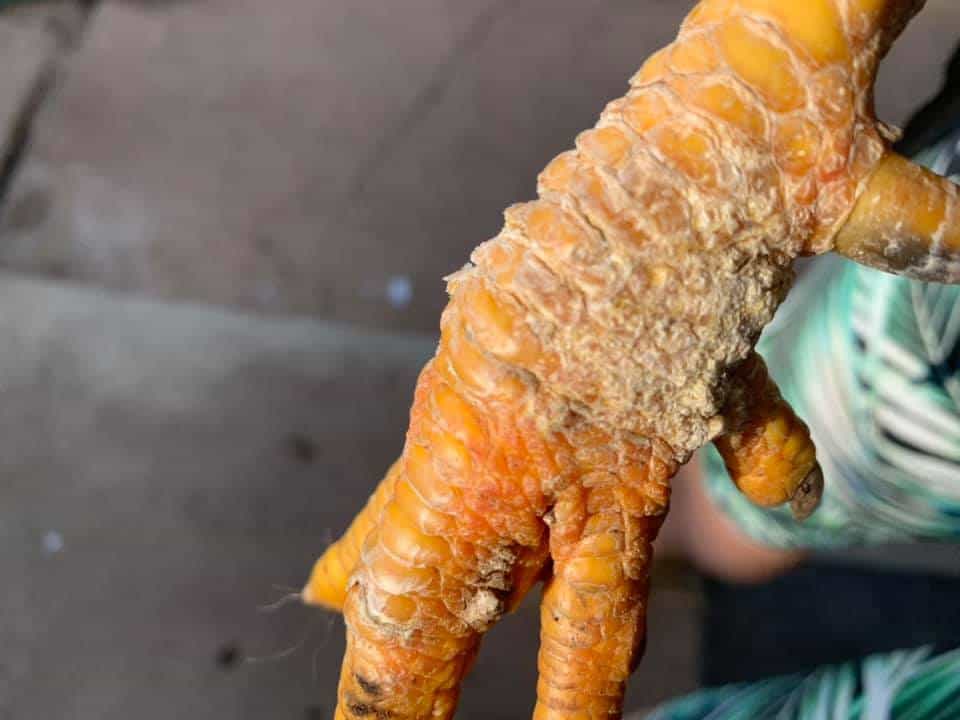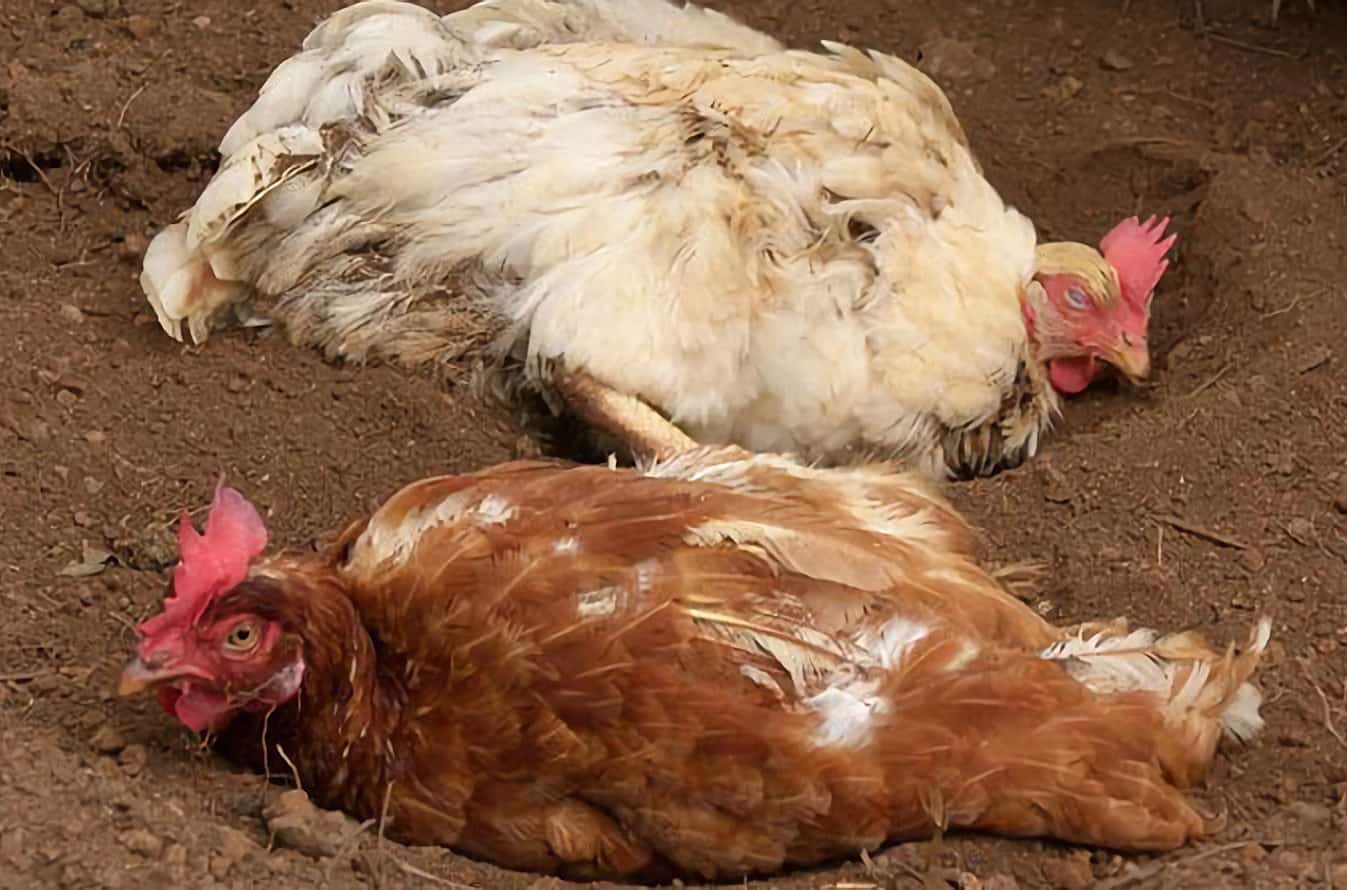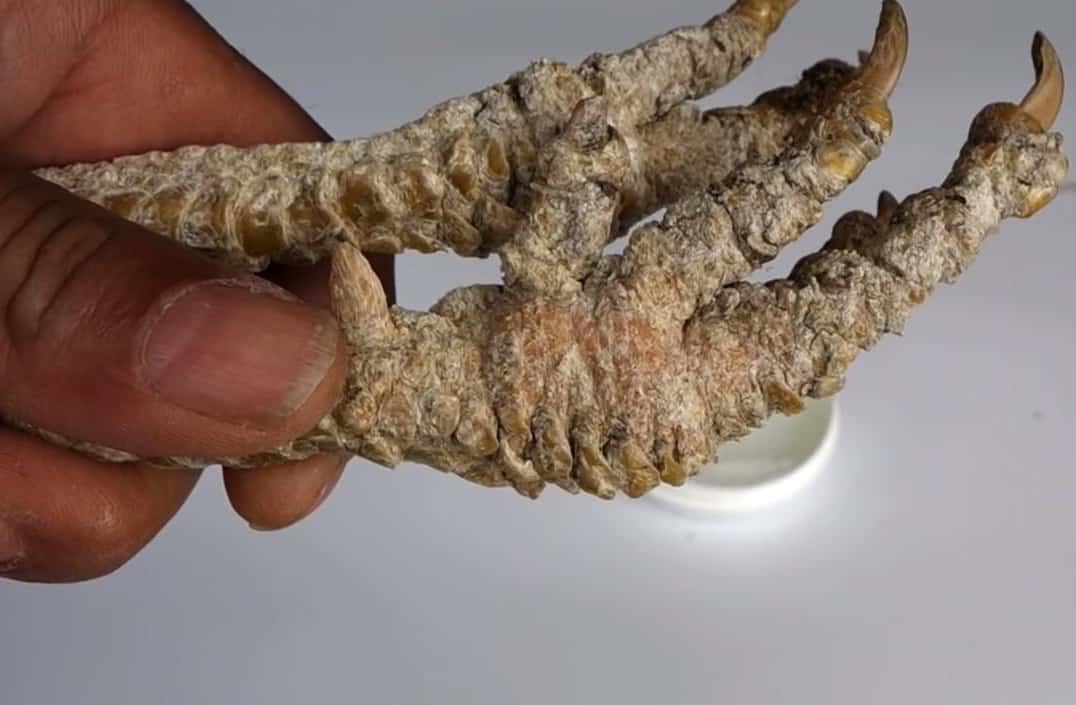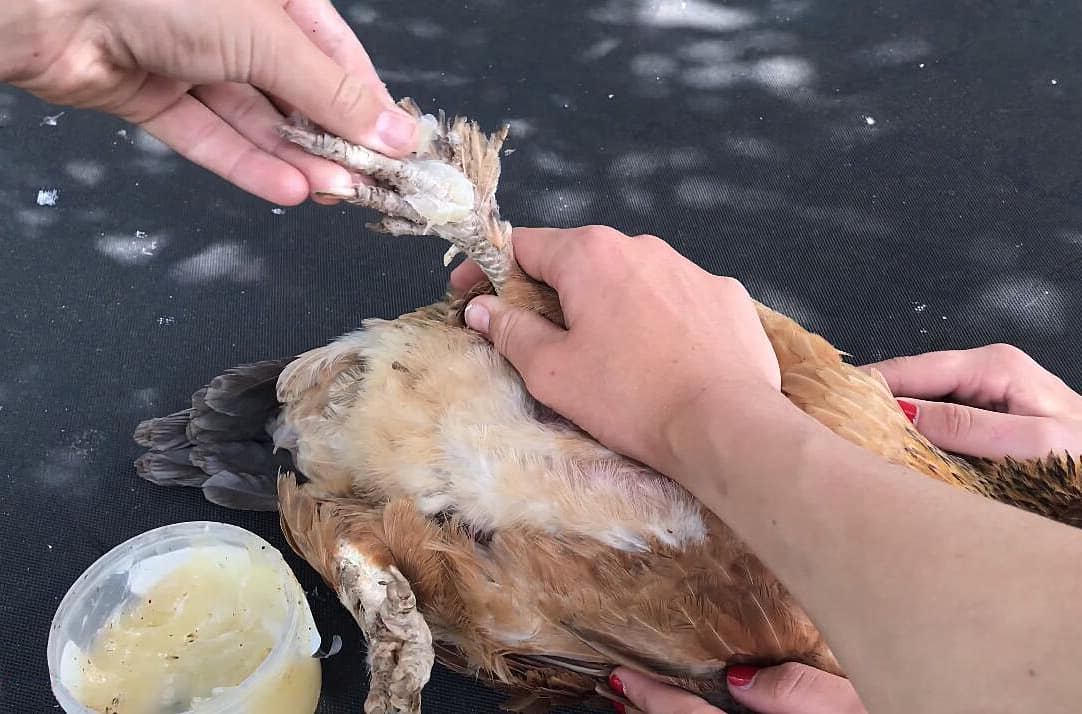Have you ever seen a chicken strutting with feet that are just gnarly and nasty looking? It’s hard to imagine anyone willing to just get near those chickens. They certainly look like they’ve got some disease.

Well, what you’re seeing is the result of the work of mites. They’re tiny, but they’re ravenous and very contagious. And if you grow your own chickens, you’d want to know how to deal with them. Just read on.
What are Scaly Leg Mites?
The Scaly Leg Mite, also known as Scaly Foot, is a super tiny arthropod, a separate family of segmented invertebrates that you know of where the spiders and scorpions are their distant relatives. They’re known in the scientific community as Knemidocoptes mutants.
It’s just that they’re very small. They’re so tiny that they can be just 0.5 millimeters small, hardly visible. Larger scaly leg mites can grow up to 25 millimeters.
They’re round in shape with four stubby legs close to their head-like extension that’s actually their retractable feeding appendage. They don’t seem to have eyes or a brain. But just like many of its relatives, the Scaly Leg Mite is a parasite engaged wholly in feeding.

The Scaly Leg Mite lays eggs, typically under the scales and tissues of bird legs such as the chicken’s. It’s the very place where these mites thrive. Female mites lay these eggs and take about two weeks to hatch, where they start out as larvae. After a few numbers of molting, they become nymphs. And with a few more molting, they become adults.
These parasites have very short lifespans compared to their arachnid relatives. Their entire life cycle lasts from 10 to 14 days.
Their primary means of dispersal is through their contact and movement of their favored host, which typically includes chickens, turkeys, passerines like finches, canaries, sparrows, and the psittacines such as parrots, parakeets, and budgerigars. They are known to also affect woodpeckers, ducks, geese, and swans. Raptors, like the Hawks, get them too.
While they’re primarily found under the scales of the bird’s legs, the comb, and the wattle, some related specie of the Scaly Leg Mite even feeds on the feather follicles, which cause balding. Their primary means of transmission is by prolonged direct contact when birds socialize.
It’s particularly so when the parent birds inadvertently infect their young. The mite also gets into the surfaces and crevices of any bird’s habitation, prompting chicken growers to sanitize the coop. They are highly contagious.
Effects of Scaly Leg Mites

Once the Scaly Leg Mites crawl between the scales of a chicken’s legs, they burrow themselves deeper, eating their way through the tissues underneath while slowly tunneling their way around. The life cycle for the scaly leg mites begins. Soon they start laying their eggs.
Scale Growth
As these mites burrow and leave behind secretions. Along with their feeding, this irritates the tissues where these mites live. These, in turn, cause excessive growth of scales. These scaly lesions look crusty and scabby, with whitish growths wherever they are infected.
Toe and Comb Deformity
These lead to deformities on their legs and toes as well as on the chicken’s wattles and comb if they get infected too. These deformities on the chicken’s feet can lead to difficulty in walking, irritation, pain, and discomfort.
And if they are not treated and instead left on their own, the condition can even mean the loss of their toes and, in extreme cases, even death as an indirect result. These affected parts become sensitive, and peeling the crusty white growths can injure the chicken.
These growths themselves are not contagious. It’s the mites that are. Thankfully, these are not the specie of mites that pass on to humans. It’s perfectly alright to touch or handle them as you work on treating your birds.
Here’s what you can do to treat them effectively without causing any pain to your chickens.
How Do You Treat Scaly Leg Mites?

You can buy products that specifically treat Scaly Leg Mites on chicken legs and feet. They’re often in handheld spray bottles, which makes them easier to apply with one hand while you hold onto the chicken with the other.
It’s still better if you’ve got an assistant, though. These contain active ingredients that kill the mites where they are underneath the leg scales of chickens and soothe their injury. They may have oil that can prevent future scaly leg mite infections.
You can buy these online from $10 to about $32 a bottle from online companies that specially sell agricultural products to hardware stores.
Here are some things you can do if you’re looking for cheaper alternatives using effective and proven DIY mixes.
Treatment 1: Warm Water – Drying – Petroleum Jelly
The most popular DIY treatment applied to treat Scaly Leg Mites on chickens is the use of petroleum jelly. A few initially soak the chicken’s legs and feet in comfortable, warm water with a soap solution before they dry them with a towel and apply the petroleum jelly.
Soaking the chicken feet in the water to remove some of the gnarly growths hanging on the chicken legs and feet. Warm water softens them while the soap solution disinfects them. Taking out some of these growths help open up more surface area for the application of petroleum jelly.
You may use gloves if you want to, but using your bare hands and fingers to make the petroleum jelly application is perfectly safe. The idea of applying petroleum jelly is to basically suffocate the mites that are burrowed under the scales.
Massaging the petroleum jelly between the scales and the cracks between the growths will help reach these hidden mites. Smothered in the petroleum jelly, they won’t be able to breathe, leading to suffocation and death. They are easily sloughed off after that.
Don’t pull off these growths on your own. Some of these are still attached to tissues underneath the growths. Pulling these out can injure your bird.
The application is often made twice to three times a week for two weeks covering the lifespan of a mite. Some farmers apply this daily.
Treatment 2: Sulfur and Petroleum Jelly Mixture

You can also apply an alternative treatment, mixing two tablespoons of sulfur powder and half a cup of petroleum jelly.
Treatment 3: Ivermectin
For serious cases of Scaly Leg Mites, a prescribed medication used specifically to treat parasitic infestations is given orally or by injection. A veterinarian normally prescribes this.
A dosage of Ivermectin, around 0.2 milligrams per kilogram per bird, is the guiding amount given once every two weeks as it’s a strong medication. It’s recommended that you’d use this as a last resort if you’d want your chickens free of any medication from its body and eggs.
Treatment 4: Gasoline – A&D Ointment
Here’s a treatment recommended by Dr. Michael Darre, Ph.D., a Poultry Extension Specialist from the University of Connecticut.
- The treatment starts with dipping the legs into the gasoline and letting them air dry on the first day. Once dry, you slather the affected legs and feet with the A&D ointment, helping them to heal. The gasoline kills off the mites.
- The next day, you apply the A&D ointment without the gasoline.
- On the third day, you do the gasoline dip, drying, and A&D application again.
Cleaning Out Your Coop
It’s not enough to treat the chicken legs and feet of the Scaly Leg Mites. These parasites do come back with a vengeance. It’s smart to treat the coop where they sleep and, when possible, their run area. You should be able to treat the surrounding area and the coop with purposely made disinfectant you can purchase online and in the store.
Another thing you can do to keep the mites affecting your flock at a minimum is to keep the area dry. Covering the grounds with hardwood wood chips will keep their feet and legs dry while sanitizing the area regularly with diatomaceous earth.
Doing routine coop disinfection will help keep the mites off of your birds or at least minimize their effects.
How to Prevent Leg Mites in Chickens
Scaly leg mites can be a real nuisance for your feathered friends! These pesky parasites are tiny but mighty and can cause inflammation, swelling, loss of feathers, and serious discomfort in chickens. But don’t worry -there are things you can do to keep them away from your coop! Such as:
- Ensure Maintaining a Hygienic Environment: Cleanliness is key! Scaly leg mites love unclean and damp environments so make sure that you’re regularly removing dirty bedding. Keep their living space nice and clean by replacing it with fresh litter- trust us; it’ll go a long way!
- Offer Dust Baths: Chickens taking dust baths is a great help to rid of these pesky mites. Not only will they get some cleaning in the process but doing this once or twice per week helps repel scaly feet too. Provide dry soil, sand mixed with wood ash, or diatomaceous earth serves great as a repellent against such pests.
- Quarantine New Chickens: Another crucial step before bringing any new birds into your flock would be full inspections. You can quarantine them for at least two weeks to ensure no diseases are passed to your flock. By inspecting new birds beforehand, you’ll be able to catch any issues early on and avoid the spread of scaly leg mites throughout your flock.
- Utilize Preventative Measures: Lastly, incorporating preventive treatments is always a good idea too- just like how we humans use bug spray for protection against mosquitos and bugs! Try using petroleum jelly-infused tea tree oil (make sure it’s safe and non-toxic for chickens) around their legs and feet as it works great at deterring these little pests without causing any harm to them.
Summary
Scaly Leg Mites are more often a nuisance, but it’s a problem worth the effort if you want your chickens to live happily in your coop. You’ll be rewarded with plump hens with lots of eggs often. Remember to keep an eye on their legs and feet. And if you see one showing signs of these mites, it’s time to treat everyone in your flock and disinfect their coop.

Joseph Hudson has been raising chickens for over 15 years. In 2018, he completed the Agriculture & Natural Resources program at Mt. San Antonio College. He currently raises over 1400 chickens on his 7.5-hectare farm. He keeps sharing his experience on raising healthy and happy chickens on Chicken Scratch The Foundry.







ok i understand all that but whats to keep the vasaline on their feet and won’t the dirt , sand , whatever stick to the vasaline? what if the chicken tries to clean that off their feet? its not really edible is it?
I was thinking the same thing!!!
From the corresponding article, it says the petroleum is to suffocate the mites more than anything. And also, it’s non-toxic 🥂
If you do it at night, the birds are much calmer and have all night for the pertoleum/ AnD to soak in while they sleep.
I use coconut oil, i melt it then brush it on with a small arts and craft paint brush. so far its worked a treat, its natural and won’t harm a chicken in any way.
Ive read in a number of hen care books to never pull off any of the scale growth as this is incredibly painful, as is the use of gasoline. Vaseline or coconut oil will do the job.